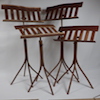So day one of the new job. Boy o boy I’m gonna have to get used to making nice stuff with nothing or get the new boss to build upon his shop.
Anyway that’s another story.
Right now I have a planer I need to tune. It’s cuts a 6” of snipe on the leading edge and 1-2” on the trailing edge.
Attached are pics of the machine. A quick rundown of what I do know. The feed rolls need adjusting. Clearly the adjustments are made a in front of the cutter with those Allen set screw with the nut and behind the head with the four Allen screws two with springs. Tighten them more pressure. Loosen them less pressure. Don’t tighten or loosen them left to right evenly and the pressure is not even and the board does not feed straight. Other than that that’s what I know.
Oh the feed roller under the cast table. Well those were a mess. I really don’t know how they are supposed to be set when zeroed out. I assume zero and or flush with the table. They were not that way. I took a straight edge and found the leading roller to be high even when zeroed. It was like 1/16 high resulting in a straight edge not being able to lay flat across the tables from to back. I adjusted that so the rollers sit exactly flush with the tables when zeroed. I used feeler gauges and a straight edge to make sure the front roller and rear roller raise and lower exactly the same. Again I have no idea if this is how they should be. It did seem to help though.
So I can almost get rid of my leading edge snipe by tightening the feed roller in front of the cutter. But as I approach no snipe the piece begins to not want to feed. The only solution to get the workpiece moving is to raise the table rollers. Problem is if I raise the table rollers the snipe gets worse again.
I was able to get things setup so I get zero snipe on the trailing edge and like 3” on the leading edge and minimal at that but what I consider terrible as I need to build right off this machine. If I lift the trailing edge of the board as I feed into the machine I can get rid of much of the leading edge snipe.
You know any amount of snipe is just not ok with me. As it is I’m gonna have to get used to building stuff without a wide belt sander and with a 12” jointer. Big stuff to not little stuff that most hobby homeowner guys can make argument for not needing fancy large machines. Point is I can’t argue with this machine it just needs to work and I need to make it work first thing in the morning.
So Im begging those that know please teach me.
My combo Felder was tuned by the the techs until I was happy. It cuts perfect to this day. My previous employer purchase a SCMI class 630 when I complained his grizzly machine that had the same exact issues as this machine was a piece of crap. I knew it was not crap but that I had no idea how to tune it and he didn’t want to pay me to learn. The SCMI machine cut perfect right out of the box. So you know I’d like that experience again but I know I also need to know how to deal with this issue new machine or old. And I don’t feel much like telling the new boss to buy a new planer. I’d much prefer he purchased me a few shapers a wide belt sander or a wide jointer.
B9830AC0-97D6-4144-B2D8-0879C50FAD1D.jpg
4A052CE0-9458-49F4-8583-E3F1A6D2DAC5.jpg
EDA8D010-F64A-458E-B04B-FC8730E5EB69.jpg




 Reply With Quote
Reply With Quote



